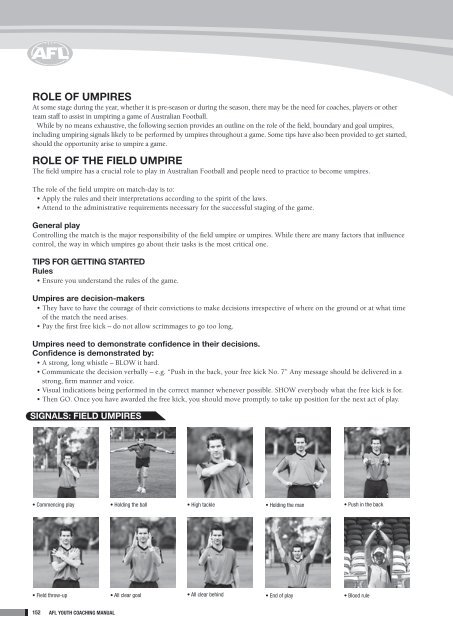2012 Youth Coaching Manual - AFL Community
2012 Youth Coaching Manual - AFL Community
2012 Youth Coaching Manual - AFL Community
You also want an ePaper? Increase the reach of your titles
YUMPU automatically turns print PDFs into web optimized ePapers that Google loves.
Role of umpires<br />
At some stage during the year, whether it is pre-season or during the season, there may be the need for coaches, players or other<br />
team staff to assist in umpiring a game of Australian Football.<br />
While by no means exhaustive, the following section provides an outline on the role of the field, boundary and goal umpires,<br />
including umpiring signals likely to be performed by umpires throughout a game. Some tips have also been provided to get started,<br />
should the opportunity arise to umpire a game.<br />
Role of the field umpire<br />
The field umpire has a crucial role to play in Australian Football and people need to practice to become umpires.<br />
The role of the field umpire on match-day is to:<br />
• Apply the rules and their interpretations according to the spirit of the laws.<br />
• Attend to the administrative requirements necessary for the successful staging of the game.<br />
General play<br />
Controlling the match is the major responsibility of the field umpire or umpires. While there are many factors that influence<br />
control, the way in which umpires go about their tasks is the most critical one.<br />
Tips for getting started<br />
Rules<br />
• Ensure you understand the rules of the game.<br />
Umpires are decision-makers<br />
• They have to have the courage of their convictions to make decisions irrespective of where on the ground or at what time<br />
of the match the need arises.<br />
• Pay the first free kick – do not allow scrimmages to go too long.<br />
Umpires need to demonstrate confidence in their decisions.<br />
Confidence is demonstrated by:<br />
• A strong, long whistle – BLOW it hard.<br />
• Communicate the decision verbally – e.g. “Push in the back, your free kick No. 7” Any message should be delivered in a<br />
strong, firm manner and voice.<br />
• Visual indications being performed in the correct manner whenever possible. SHOW everybody what the free kick is for.<br />
• Then GO. Once you have awarded the free kick, you should move promptly to take up position for the next act of play.<br />
Signals: Field umpires<br />
• Commencing play • Holding the ball • High tackle<br />
• Holding the man<br />
• Push in the back<br />
• Field throw-up<br />
• All clear goal<br />
• All clear behind<br />
• End of play<br />
• Blood rule<br />
152 <strong>AFL</strong> <strong>Youth</strong> <strong>Coaching</strong> <strong>Manual</strong>

















